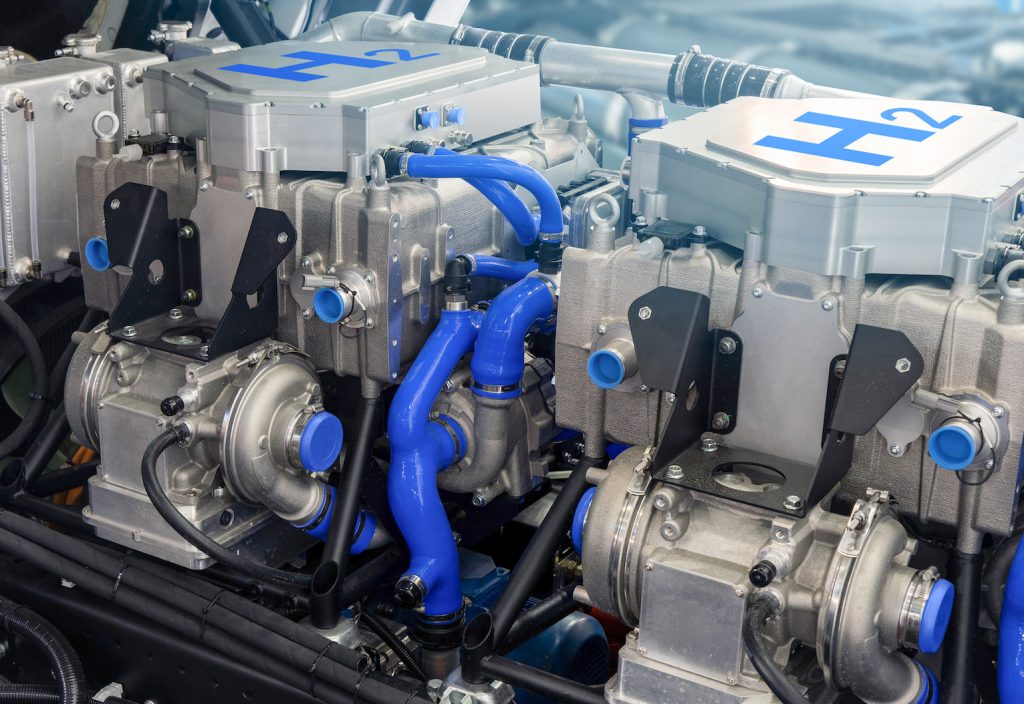Decarbonising the global economy and achieving net-zero emissions by 2050 will require identifying and targeting the major emitters of carbon dioxide.
According to the CSIRO, the transport sector is Australia’s second largest emitter, contributing 19 per cent towards our gross carbon emissions. Decarbonising this sector is becoming increasingly urgent. Of transport emissions in 2019, light vehicles were responsible for 62 per cent with trucks pumping out 20 per cent of total transport emissions.
To decarbonise the transport industry, hydrogen which can power a fuel cell with zero emissions, could be used as an alternate fuel for petroleum products.
The heat-energy value of hydrogen is 142 MJ/kg while the heat-energy of petroleum products is only 44 MJ/kg; hydrogen fuel releases three times the heat energy during combustion.
One kilogram of hydrogen contains 33.3 kWh of usable energy, whereas petrol and diesel contain approximately 12 kWh/kg of usable energy. The engine efficiency of an internal combustion engine is approximately 25 to 30 per cent, while the efficiency of a hydrogen fuel cell is 40 to 50 per cent. Hydrogen as a fuel carries significantly more energy than the equivalent weight of batteries.
However, for a hydrogen industry to develop, large-scale electrolysers, renewable electricity, storage facilities, water supply and infrastructure will be required — along with considerable investment.
It’s not new technology
The first fuel cell was invented in 1838 by William Grove, a Welsh judge and scientist. His battery-like cell turned hydrogen and oxygen into electricity and water, using zinc and platinum electrodes exposed to an acid.
It was close to 100 years later — 1932 — when English engineer Frances Thomas Bacon, developed the first commercial hydrogen-to-oxygen fuel cell, which converted air through a direct electrochemical process.
The Bacon fuel cell has been used by NASA since the 1960s for powering satellites and in the Apollo Moon missions.
How it works
A fuel cell is a package located under the bonnet of a motor vehicle. A pressure cylinder supplies hydrogen gas to this cell, and through a chemical process, it produces electrical energy that powers a DC circuit to the drive motors.
The fuel cell’s process involves releasing hydrogen to an anode while ambient air is ducted to a cathode.
The catalyst at the anode separates hydrogen molecules into protons and electrons which take different paths to the cathode. The electrons pass through an external circuit creating a flow of electricity.
Protons then migrate through the electrolyte to the cathode, where they unite with oxygen and the electrons to form water and heat. Electricity is produced by combining hydrogen and oxygen atoms.
Hydrogen is used in fuel cells because of its availability, high energy density and environmentally friendly by-product; it leaves only water. There is no emission of air pollutants, and an electrochemical cell, unlike a traditional battery, does not run down or need recharging.
Hydrogen can also fuel an internal combustion engine, but burning hydrogen produces nitrogen oxide emissions and is less efficient than using it in fuel cells.
Developing a hydrogen industry
Unlike traditional energy sources, hydrogen does not exist in specific locations in concentrated forms.
It can be produced using several processes from a range of resources containing hydrogen.
The process most often associated with current discussions about clean hydrogen is to use an electrolyser, which passes current through water, to make “green” hydrogen, which requires renewable electricity and water as inputs.
The alternative is to make “blue” hydrogen, which is produced using traditional means of steam methane reforming or coal gasification —processes that produce carbon dioxide.
Of the world’s hydrogen, 96 per cent is produced from fossil fuels such as coal or natural gas.
An Australian hydrogen industry would require large-scale electrolysers, renewable electricity, storage facilities, water and water pipelines, hydrogen pipelines, electricity infrastructure and refuelling stations.
A recent CSIRO report noted that hydrogen has reached price parity with diesel. Diesel therefore presents an immediate opportunity for the development of a hydrogen market.
Road transport diesel replacement opportunities include trucks and buses, which are predominantly fuelled by diesel— in 2020, there were over 600,000 diesel trucks in Australia. Of the country’s 14 million passenger vehicles, however, only 13 per cent use diesel.
In general, vehicle manufacturers acknowledge hydrogen’s carbon-reduction potential, but cannot see a current business case for conversion. Concerns include a lack of refuelling infrastructure, insufficient market demand, full lifecycle costs, a lack of a second-hand market and inconsistency with overseas vehicle in standards.
Testing the waters
One company making use of hydrogen is Fortescue Metals Group, which is decarbonising its fleet of 120 Liebherr haul trucks, representing approximately 45 per cent of its current haul truck fleet.
Truck haulage consumed approximately 200 million litres of diesel in the 2021 fiscal year and accounted for 26 per cent of Fortescue’s total emissions.
The Liebherr haul trucks will be powered by both battery electric and hydrogen fuel cell technology and will be operational within the Fortescue mine sites by 2025.
Elsewhere, a wastewater treatment plant in Goondiwindi, Queensland, is likely to become one of Australia’s first to expand into hydrogen production and create a hydrogen economy for the region.
Power generation from a 2.5 MW solar farm to an electrolyser system will produce “green” hydrogen that will be sold to local customers, including the agricultural and industrial markets.
The oxygen produced during the production process will be redirected into aerating the plant’s wastewater.
Climate Smart Engineering 2023 (CSE23) will be held 29-30 November 2023 at the Melbourne Convention and Exhibition Centre. Call for abstracts and registrations are now open.
Abstract submissions close 11.59 pm AEST on Wednesday 12 April 2023.

